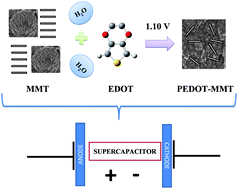Hybrid polythiophene–clay exfoliated nanocomposites for ultracapacitor devices
Abstract
Exfoliated nanocomposites of poly(3,4-ethylenedioxythiophene) (PEDOT) and montmorillonite (MMT) have been prepared by in situ anodic

Maintenance work is planned for Wednesday 1st May 2024 from 9:00am to 11:00am (BST).
During this time, the performance of our website may be affected - searches may run slowly and some pages may be temporarily unavailable. If this happens, please try refreshing your web browser or try waiting two to three minutes before trying again.
We apologise for any inconvenience this might cause and thank you for your patience.
* Corresponding authors
a
Departament d'Enginyeria Química, E. T. S. d'Enginyers Industrials, Universitat Politècnica de Catalunya, Diagonal 647, 08028 Barcelona, Spain
E-mail:
carlos.aleman@upc.edu
b Center for Research in Nano-Engineering, Universitat Politècnica de Catalunya, Campus Sud, Edifici C', C/Pasqual i Vila s/n, Barcelona E-08028, Spain
c
Institute of Chemistry, Federal University of Rio Grande do Sul, Av. Bento Gonçalves 9500, Porto Alegre, RS Brazil
E-mail:
denise@iq.ufrgs.br
d Unitat de Química Industrial, Escola Universitària d'Enginyeria Tècnica Industrial de Barcelona, Universitat Politècnica de Catalunya, Comte d'Urgell 187, 08036 Barcelona, Spain
e Universidade Federal do Rio Grande do Sul, DEMAT, Av. Bento Gonçalves, 9500 - setor 4- prédio 74, Porto Alegre, RS – Brazil
Exfoliated nanocomposites of poly(3,4-ethylenedioxythiophene) (PEDOT) and montmorillonite (MMT) have been prepared by in situ anodic

 Please wait while we load your content...
Something went wrong. Try again?
Please wait while we load your content...
Something went wrong. Try again?
D. Aradilla, D. Azambuja, F. Estrany, M. T. Casas, C. A. Ferreira and C. Alemán, J. Mater. Chem., 2012, 22, 13110 DOI: 10.1039/C2JM31372C
To request permission to reproduce material from this article, please go to the Copyright Clearance Center request page.
If you are an author contributing to an RSC publication, you do not need to request permission provided correct acknowledgement is given.
If you are the author of this article, you do not need to request permission to reproduce figures and diagrams provided correct acknowledgement is given. If you want to reproduce the whole article in a third-party publication (excluding your thesis/dissertation for which permission is not required) please go to the Copyright Clearance Center request page.
Read more about how to correctly acknowledge RSC content.
 Fetching data from CrossRef.
Fetching data from CrossRef.
This may take some time to load.
Loading related content
